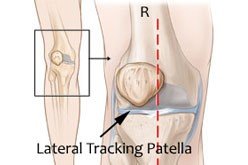Anterior Knee Pain - What causes it & 3 simple solutions.
Anterior knee pain is most commonly the result of patella-femoral pain syndrome, of PFJ Syndrome, whereby there is reoccurring irritation in the front of the knee resulting in ongoing pain. Symptoms of PFJ Syndrome include pain at the front of the knee and under the kneecap, as well as a vague ache in the knee joint. There is also often tenderness along the inside border of the kneecap and sometimes swelling will occur after exercise.
So what causes PFJ Syndrome?
The exact cause of PFJ Syndrome is not entirely known but it is thought PFJ Syndrome occurs when the patella (kneecap) rubs on the femur bone underneath, resulting in significant irritation of the articular cartilage underneath the patella. This rubbing can occur if the patella does not track properly in its groove. It’s important to note that irritation to the cartilage itself cannot directly cause anterior knee pain because there are no blood vessels or nerves in cartilage. Rather, it leads to other problems, which in turn result in pain. These include inflammation of the knee joint lining (synovitis), erosion of the bone under the patella, irritation to the lateral retinaculum of the knee and/or irritation of the infra patella fat pad.
Usually the initial trigger of PFJ Syndrome is overuse from either external or internal factors. External factors include things like repetitive high intensity jumping or an increase in physical training. Internal factors include altered knee biomechanics like poor patella tracking as well as muscular imbalances. These factors can lead to an undue amount of pressure being placed on the front of the knee, in turn triggering a cycle of events that results in pain. It’s important to determine the cause of your anterior knee pain, so the cause can be resolved rather than just treating the symptoms.
3 Simple Solutions!
In most cases it takes a good rehab program and physiotherapy for people with PFJ Syndrome to become completely pain free. There are some simple interventions though that can help to reduce symptoms and therefore alleviate some pain. Remember that these solutions may not ‘fix’ the problem so it’s always best to consult with your physiotherapist to rule out any other potential causes of your anterior knee pain.
Simple Solution Number 1:
Fire up your glutes! It many cases of PFJ Syndrome the gluteal muscles are either weak or inactive, resulting in muscle imbalances and a lack of control around the hip and knee joints. Strengthening the gluteal muscles and working on motor control around the pelvic area can have a flow-on effect down the leg and can help to reduce pain associated with PFJ Syndrome.
Simple Solution Number 2:
Check your footwear! Wearing shoes that properly support your feet is really important if you suffer from anterior knee pain. Biomechanics at the ankle have a large impact on the knee and can adversely affect the knee if the foot is not properly supported. In order to work out what sort of footwear is best for you, seek advise from your Fleurieu Physiotherapy & Wellness physiotherapist or check in with a podiatrist.
Simple Solution Number 3:
Change the way you exercise! Certain exercises load up the knees more than others, leading to increased strain through the joint. Low-load exercises like swimming and hydrotherapy are great options for people with knee pain – Goolwa Physio can set you up with a hydrotherapy program.
In any pain presentation it is best to always seek professional advice first, such as that from Goolwa Physio, so your treatment specifically targets the cause of your pain. To make an appointment at Goolwa Physio click the ‘book online’ tab or call us today.



